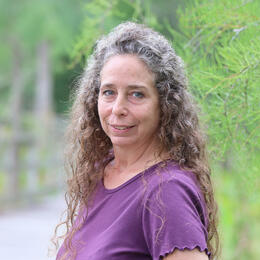Nearly 100 environmental professionals from across Southwest Florida attended the 2024 Corkscrew Watershed Science Forum on May 10. Held this year at the University of Florida/IFAS office in Collier County, the event included 13 presentations by scientists and conservation professionals with Audubon Florida, South Florida Water Management District, University of Florida, and more. Their work covered wide-ranging topics, from the Comprehensive Everglades Restoration Plan to lichens, mosquito control to Snail Kites. Many projects presented had both a local focus and far-reaching impacts, sharing lessons learned, best practices, and resourceful information for all who work or live in the watershed.
The daylong event kicked off with remarks by Sanctuary Director Keith Laakkonen, who highlighted the Sanctuary’s 70th anniversary and connections to the coast. Three Audubon staff members presented during the forum.
Wood Stork Declines
Shawn Clem, PhD, director of conservation, provided a retrospective on the loss of shallow wetlands and the resulting loss of Wood Stork nesting in the region. She highlighted the importance of long-term datasets for informing land and water management. The birds are telling us that there is a lot of work to do in this system for the benefit of all wildlife and people. In response to this identified need, South Florida Water Management District Big Cypress Basin has begun to seek solutions. Read more about issues facing Wood Storks at Corkscrew Swamp Sanctuary.
Monitoring Restoration Progress
Biologist Jacob Zetzer shared an update on the restoration taking place at the Sanctuary and monitoring efforts. While aerial images document a large-scale reduction of Carolina willow (a native nuisance species), species-level transect data demonstrate increasing coverage of native grasses and sedges that will ultimately support fire and provide better wildlife habitat. Once restored, staff will manage these habitats with prescribed fire every two to five years, maintaining conditions that fish, birds, and other marsh wildlife need to flourish. The approximate cost of this restoration is $3,500 per acre, and nearly 1,400 acres are now in various stages of restoration at the Sanctuary. Read more about the Marsh and Prairie Restoration.
Smart Growth
Brad Cornell serves as the Southwest policy associate for Audubon Florida and Audubon of the Western Everglades and his presentation on smart growth was riveting. After defining the value and benefits of smart growth, he showed the National Oceanic and Atmospheric Administration’s annual overview of “billion-dollar weather and climate disasters.” These events, worsened by climate change, show the importance of resilience and the benefits of taking steps now to avoid more costly disasters in the future. Large-scale efforts like Everglades restoration, wildlife corridors, and springs restoration are critical, and we must also take steps as individuals, neighborhoods, and municipalities to educate and empower people to build back stronger after disasters. We still have great opportunities to build more sustainable communities to accommodate the influx of residents in our state. With more native plants, less grass, and more wetland plants in manmade lakes, we can save water while supporting the fish and insects that birds need to survive while making ourselves more resilient to catastrophic events.
Founded by Audubon in 2015 and held at Corkscrew Swamp Sanctuary until this year, this one-day meeting annually brings together scientists, engineers, and other professionals working within the Corkscrew Watershed to present their work to their colleagues, policy staff, decision makers, volunteers, and the general public. The result is a regional forum for networking, productive discussion, and building collaborations aimed at informing and advancing conservation efforts across Southwest Florida.
Find summaries from other presentations shared at the event here.





